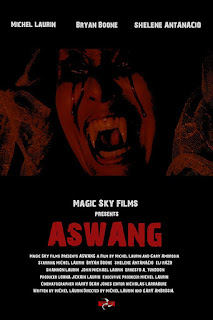Director: Patrick Graham
First aired: 2018
Contains spoilers
This is an Indian mini-series, made for Netflix and combines a dystopian future with the supernatural and – if we are going to be honest – a large dollop of
the Thing (1982) and does so with a massive amount of style. The horror (and gore) building through the three episodes until it crescendos.
First thing, of course, is I am going to have to tackle the fact that it is based on a version of the Arabian Ghoul before someone comments and says “
it’s a ghoul not a vampire”. The fact is the two creatures have been closely linked for quite some time. The ghoul as a creature from Arabic myth entered into Western consciousness as it was mentioned several times in the
Arabian Nights, as translated into French by Antoine Galland in the 18th Century. The story of most interest is
The History of Sidi Nu’uman, which tells of a man suspicious because his new bride never seems to eat. Long story short he follows her to a cemetery and witnesses her indulging in eating the dead with the other ghouls.
 |
| fanged teeth |
Cut forward to 1821 and E.T.A. Hoffmann published a story entitled
Vampirismus as part of his
Die Serapions-Brüder. There is every chance that the story title was added by an editor as the story is essentially a reworking, into a modern Western setting, of
The History of Sidi Nu’uman. Jump forward a century and Dudley Wright adds the same story into his reference book
Vampires and Vampirism and Summers conflates ghouls and vampires in
The vampire, His Kith and Kin (1928). Ghouls were used in the work of HP Lovecraft and his ghoul story
Pickman’s Model (1927) was reworked by Neil Gaiman, with a vampiric twist, in his film
A Short Film About John Bolton.
 |
| the squad |
In this case we start with a man cutting into his own flesh so that he can gather his own blood to paint out a glyph, a blood ritual that will summon the ghoul – we’ll come back to this. We are in an India of the near future, a radically different place from now. There is a military clampdown and a rampant (and I daresay popularist) nationalism. We follow a military raid on a terrorist base, looking for terrorist leader Ali Saeed (Mahesh Balraj). A man approaches the squad, saying “
they’re all dead”. When they get to where Saeed is there are bodies and he sits there. He whispers something to the squad leader.
 |
| Radhika Apte as Nida |
Jumping back a month and Nida Rahim (Radhika Apte), a young Muslim woman, is in a car with her father (S.M. Zaheer). He is taking her back to the academy of the National Protection Squad, where she is being trained in interrogation techniques, but he is complaining about raids and the burning of books. He reveals he has books that he has rescued in the car and his lecture notes – he’s been teaching off-syllabus. They reach a checkpoint and he becomes defensive but Nida intervenes to get them past. However, she thinks on his actions and the propaganda she is fed, and reports him – he is sent to a re-education centre but not before she reveals she has done this to him.
 |
| torturing Saeed |
Nida is pulled out of the academy early and posted to a detention centre (the one her father was sent to). There is a difference of opinion of how to treat her. Commander of the post, Colonel Sunil Dacunha (Manav Kaul), wants her put on the squad who are to interrogate Ali Saeed (who is being transported there that day), but his Lieutenant, Laxmi Das (Ratnabali Bhattacharjee), doesn’t trust her and thinks she is a terrorist/sympathiser. It soon becomes apparent that Saeed is more than he appears and this is shown at first through mind games that get his interrogators turning on each other. Quickly it is revealed that he is the ghoul.
 |
| it's behind you |
So, what are its powers – having been summoned, its purpose is to reveal their guilt and eat their flesh. There seems to be some level of telepathy involved, so that it can manipulate people – causing fights and generally freaking people out. However the primary power is that the ghoul will eat the flesh of victims and take the form of the last person it bit (hence dropping the pronoun to it). This transformation can occur whether the victim is alive or dead. This leads to
the Thing aspect, with the series playing with the “who is it” card a few times. The ghoul can reveal sharp teeth, talons and black eyes. It does also appear to be very physically hardy.
 |
| hunting the ghoul |
I really enjoyed this. It had a dark atmosphere with the dystopian setting, the torture/detention centre, the characters who were all fatally flawed one way or another and the gore and violence that built through the three episodes. It was superbly acted and, yes, it was derivative but in a good way. Whether you’d throw this into vampire filmographies depends on how wide you cast your vampire net but this ghoul certainly eats fresh flesh and not longer dead corpses (as is the norm through a lot of ghoul material) and can shapeshift (again not a power normally put in ghoul related material, more a vampiric power).
7.5 out of 10 and recommended.
The imdb page is
here.






































































